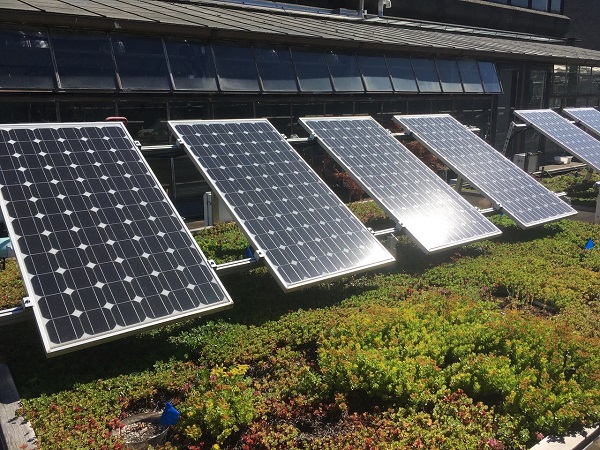
November 19, 2019, by Blue-Green team
Ecoroofs in Portland, Oregon, USA
Authors: Noelwah R. Netusil and Ben Thomas, Reed College (Portland, Oregon).
Portland, Oregon, USA was identified as an international leader in the Blue-Green Futures questionnaire that explored the perceived benefits, beneficiaries, multifunctionality and challenges of planning and delivering Blue-Green infrastructure (see our earlier blog).
Portland has relied heavily on green infrastructure (GI) projects, such as ecoroofs (also known as green roofs or living roofs) and green streets to reduce stormwater runoff (Figures 1-3). The primary driver for adopting these approaches is to reduce flooding and combined sewer overflows, but other GI benefits include a reduction in urban water pollution and the creation of open space.

Figure 1. Ecoroof on the Academic and Student Recreation Center at Portland State University. Photo credit: Noelwah Netusil.

Figure 2. Solar panels and vegetation on top of the Science Research and Teaching Center at Portland State University. Photo credit: Noelwah Netusil.

Figure 3. Ecoroof on the Academic and Student Recreation Center at Portland State University. Photo credit: Noelwah Netusil.
Ecoroof dimensions and policies
Portland has used a combination of education, incentive-based policies, and regulations to increase the number of ecoroofs. An ecoroof incentive program, which was in place from 2008-2012, provided private developers with a subsidy of up to $5 per square foot and the potential to qualify for a building density bonus (Environmental Services 2019). As of 2019, there were almost 400 ecoroofs in the city of Portland with 152 ecoroofs (almost 1 million square feet) on properties with a commercial use (Table 1). Institutional buildings, which include colleges, universities and hospitals, accounted for almost the same total square footage as government buildings.
While residential buildings with ecoroofs are distributed around the city, ecoroofs on commercial, government and institutional buildings are more concentrated in downtown Portland (Figure 4).

Table 1. Portland Ecoroof Building Use and Square Footage (Source: Portland State University, Portland’s Greenroof information Thinktank (GRiT), and Portland State University’s Home Ecology Research (HERE) Lab).

Figure 4. Ecoroof Location in Portland by Building Use (Source: Portland State University, Portland’s Greenroof information Thinktank (GRiT), and Portland State University’s Home Ecology Research (HERE) Lab).
Central City Plan 2035
In May 2018, the Portland City Council adopted the Central City 2035 Plan that added an ecoroof requirement to Portland’s Zoning Code for new buildings with a net building area of 20,000 square feet or more (Environmental Services 2018; City of Portland 2019). This is viewed as one of the most (if not the most) stringent ecoroof requirement in the US. However, the three buildings that would have been required to install an ecoroof as part of the new requirement received exemptions.
Ecoroof research
Much research exists on the private benefits from ecoroofs such as the reduction in energy costs and increased roof lifespan. As detailed in “Valuing the Benefits of Green Stormwater Infrastructure” (Ando and Netusil 2018), there exists a gap in the literature on valuing the public benefits of ecoroofs such as the benefits from allowing public access, reducing stormwater runoff (and combined sewer overflows), mitigating the urban heat island effect, and increasing the number of pollinators. A research team from Reed College (Noelwah R. Netusil), Portland State University (Sahan Dissanayake), and the University of Illinois at Urbana-Champaign (Amy W. Ando) is in the process of designing a choice experiment to value the public benefits from ecoroofs with a goal of sharing their findings with policymakers and ecoroof designers.
References
Ando, Amy W., and Noelwah R. Netusil. 2018. Valuing the Benefits of Green Stormwater Infrastructure. Vol. 1. Oxford University Press. https://doi.org/10.1093/acrefore/9780199389414.013.605.
City of Portland Environmental Services. 2018. Guidance on CC2035 Ecoroof Requirements and the SWMM. Available at: https://www.portlandoregon.gov/bes/article/691262
City of Portland Environmental Services. 2019. Portland Ecoroofs. Available at: https://www.portlandoregon.gov/bes/44422
City of Portland. 2019 Central City Plan, Title 33, Planning and Zoning (§33.510.243 Ecoroofs) (March 1). Available at: https://www.portlandoregon.gov/bps/article/53363
Portland State University, Portland’s Greenroof information Thinktank (GRiT), and Portland State University’s Home Ecology Research (HERE) Lab. 2019. Portland Ecoroof Map. Available at: https://ecoroofs.research.pdx.edu/#!/
No comments yet, fill out a comment to be the first

Leave a Reply